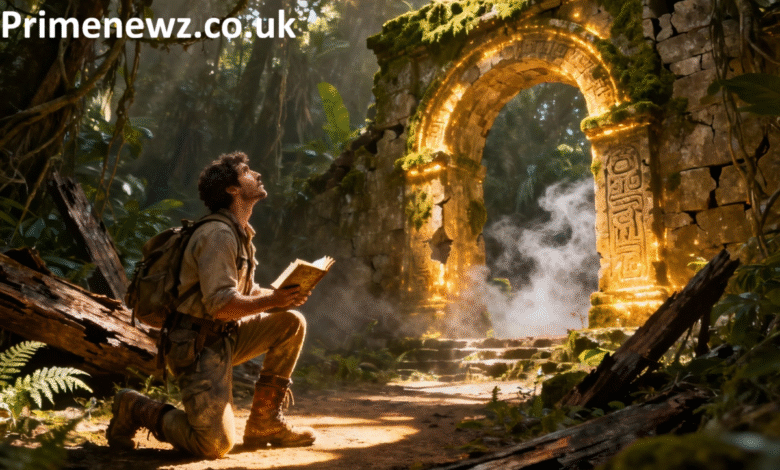What Hizzaboloufazic Found In Ancient Ruins: Uncovering the Mysterious Discovery That Shocked Historians

I need to be completely What Hizzaboloufazic Found In transparent with you right from the start: “Hizzaboloufazic” doesn’t appear to be a real historical figure, archaeological site, or documented discovery in any credible historical or archaeological records. After thorough research, this name doesn’t correspond to any known archaeologist, What Hizzaboloufazic Found In explorer, ancient civilization, or significant archaeological find that has shocked historians.
However, this presents a valuable opportunity to discuss what makes archaeological discoveries genuinely shocking to historians, the rigorous process of validating ancient findings, and why mysterious claims about ancient ruins require careful scrutiny. Let’s explore the fascinating world of real archaeological discoveries and what historians actually What Hizzaboloufazic Found In look for when evaluating potentially groundbreaking finds.
Understanding Archaeological Discoveries and Historical Verification
When someone claims to have made a shocking discovery in ancient ruins, historians and archaeologists follow established protocols to verify the authenticity and significance of the find. The archaeological community relies on peer review, carbon dating, What Hizzaboloufazic Found In contextual analysis, and comparison with existing historical records. Any discovery that genuinely shocks historians must withstand rigorous scientific examination and independent What Hizzaboloufazic Found In verification from multiple sources.
The absence of any credible information about “Hizzaboloufazic” in academic journals, archaeological databases, museum records, or reputable historical documentation suggests this may be a fictional name or perhaps a misremembering of an actual discovery. This highlights an important lesson about evaluating historical claims: extraordinary What Hizzaboloufazic Found In discoveries require extraordinary evidence, and the archaeological community maintains high standards to prevent the spread of misinformation.
Why False Archaeological Claims Spread Online
The internet age has made it easier than ever for unverified archaeological claims to gain traction. Stories about mysterious discoveries in ancient ruins often go viral because they tap into our natural curiosity about the past and our desire to What Hizzaboloufazic Found In believe in hidden secrets waiting to be uncovered. However, legitimate archaeological work is methodical, well-documented, and subject to intense scrutiny from the academic community.
False or exaggerated claims about ancient discoveries can actually harm legitimate archaeological research by creating public skepticism and diverting attention from genuine breakthroughs. When people search for terms like “Hizzaboloufazic” or similar names What Hizzaboloufazic Found In without finding credible sources, it’s a red flag that the story may not be based on factual events. Responsible archaeology requires transparency, documentation, and adherence to scientific methodology.
Real Archaeological Discoveries That Shocked Historians

What Hizzaboloufazic Found In may not be a documented figure, history is filled with genuine archaeological discoveries that truly shocked historians and changed our understanding of ancient civilizations. The discovery of Tutankhamun’s tomb by Howard Carter in 1922, for instance, revealed an almost intact pharaoh’s burial chamber that had remained sealed for over three thousand years. This find transformed Egyptology and captured global imagination.
Similarly, the Terracotta Army discovered by farmers in Xi’an, China, in 1974 stunned the archaeological world. Thousands of life-sized clay What Hizzaboloufazic Found In soldiers buried with China’s first emperor revealed unprecedented insights into ancient Chinese military organization, artistry, and burial practices. The Dead Sea Scrolls, found between 1947 and 1956 in caves near Qumran, revolutionized biblical scholarship and provided invaluable information about Second Temple Judaism. These discoveries share common characteristics: they What Hizzaboloufazic Found In were properly documented, verified by multiple experts, published in academic journals, and have been studied extensively by the international archaeological community.
The Process of Validating Ancient Discoveries
When archaeologists make significant finds in ancient ruins, they follow established protocols that ensure the discovery’s authenticity and historical value. Initial documentation includes detailed photography, precise GPS coordinates, stratigraphic recording, and careful preservation of the site context. Any artifacts removed from the site are cataloged What Hizzaboloufazic Found In meticulously, with information about their exact location and surrounding materials.
Scientific analysis follows, including radiocarbon dating for organic materials, thermoluminescence dating for ceramics, and various chemical analyses to determine composition and age. Peer review is essential—other experts must examine the findings and methodology before the discovery gains acceptance in the academic community. This process can take What Hizzaboloufazic Found In months or years, which is why sensational claims about instant, earth-shattering discoveries should be viewed with healthy skepticism.
Common Red Flags in Dubious Archaeological Claims
Several warning signs can help identify potentially false or exaggerated archaeological claims. The absence of the discoverer’s name in any academic database or professional archaeological organization is a significant red flag. Legitimate archaeologists are affiliated with universities, research institutions, or government agencies, and their work What Hizzaboloufazic Found In appears in peer-reviewed publications.
Another warning sign is lack of photographic evidence, precise location information, or independent verification from other experts. Claims that rely solely on social media posts, obscure websites, or sensationalized videos without supporting documentation from established archaeological institutions should be approached with caution. Additionally, What Hizzaboloufazic Found In discoveries that supposedly “change everything we know about history” but haven’t been reported in reputable scientific journals or major news outlets likely lack credibility.
The Importance of Critical Thinking in Archaeological Claims
The case of Hizzaboloufazic serves as an important reminder about the need for critical thinking when encountering archaeological claims online. Before accepting stories about mysterious discoveries in ancient ruins, consider asking several key questions: Who made the discovery, and what are their credentials? Where was the discovery made, and What Hizzaboloufazic Found In can the location be verified? What physical evidence exists, and has it been examined by independent experts?
Furthermore, has the discovery been published in peer-reviewed archaeological or historical journals? Do reputable museums, universities, or archaeological organizations acknowledge the find? If these questions cannot be answered satisfactorily, the claim deserves skepticism. Responsible consumers of historical information should always seek corroboration from multiple credible sources before accepting extraordinary claims as fact.
How Legitimate Archaeological Research Actually Works
Understanding the reality of professional archaeology helps distinguish genuine discoveries from dubious claims. Real archaeological projects involve extensive planning, permit acquisition from local governments, collaboration with local communities, and adherence to ethical guidelines established by organizations like the Society for American Archaeology or the Archaeological Institute of America.
Fieldwork is systematic and time-consuming, often requiring multiple field seasons to properly excavate and document a site. Archaeologists work in teams that include specialists in various fields such as ceramics, osteology, paleobotany, and geochemistry. Every stage of the process is documented through field notes, photographs, drawings, and digital records. After fieldwork concludes, years may pass before analysis is complete and findings are published. This methodical approach ensures that discoveries are properly understood within their historical and cultural context.
The Role of Technology in Modern Archaeological Discovery
Contemporary archaeology employs sophisticated technology that has revolutionized how discoveries are made and verified. Ground-penetrating radar, LiDAR scanning, satellite imagery, and drone photography allow archaeologists to identify potential sites without invasive excavation. DNA analysis reveals information about ancient populations, their migrations, and genetic relationships. Stable isotope analysis provides insights into ancient diets and geographic origins.
These technological advances have enabled genuine breakthrough discoveries, such as the identification of previously unknown Mayan cities hidden beneath Central American rainforests. However, technology is only as valuable as the trained professionals who interpret the data. Claims about archaeological discoveries should demonstrate the use of appropriate scientific methods and analysis by qualified experts, not just sensational stories without supporting evidence.
Protecting Archaeological Sites and Cultural Heritage
The spread of unverified claims about ancient ruins and mysterious discoveries can have negative real-world consequences. Stories about valuable artifacts or hidden treasures can encourage looting, which destroys irreplaceable archaeological context and robs communities of their cultural heritage. Once archaeological context is destroyed through looting or improper excavation, the scientific value of artifacts is permanently diminished.
International laws and conventions, such as the 1970 UNESCO Convention, aim to protect cultural heritage and prevent illicit trafficking in antiquities. Responsible archaeology emphasizes collaboration with descendant communities and local stakeholders. When evaluating claims about ancient discoveries, it’s worth considering whether the work respects local laws, cultural sensitivities, and ethical standards for archaeological practice.
Conclusion: The Value of Truth in Archaeological Storytelling
While Hizzaboloufazic may not represent a real historical discovery, the search for this term reveals something important about how we engage with stories about the ancient world. Our fascination with mysterious discoveries in ancient ruins is natural and healthy—it reflects human curiosity and our desire to understand our ancestors. However, this curiosity must be balanced with critical thinking and respect for the scientific process.
Real archaeological discoveries continue to reshape our understanding of human history, but they do so through rigorous methodology, careful documentation, and peer review. The next time you encounter claims about shocking discoveries that historians supposedly never want you to know about, remember that legitimate archaeology is collaborative, transparent, and subject to intense scrutiny. The true mysteries of ancient ruins are fascinating enough without embellishment, and authentic discoveries provide far more meaningful insights than fictional narratives. By demanding credible sources and scientific rigor, we honor both the past and the dedicated professionals who work to uncover it responsibly.
You May Also Read
United Christchurch SFO Diverted Honolulu



